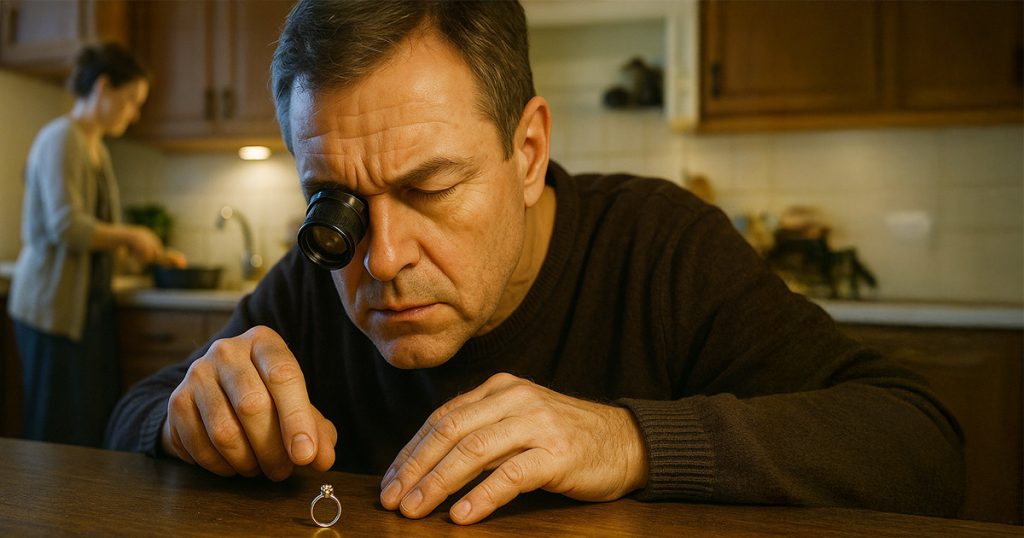Gold jewelry has long symbolized luxury and value. However, not all gold jewelry you see is authentic. There’s no need for pricey gadgets or expert skills. With just a few simple methods, you can determine if your jewelry is genuine or gold-plated.
1. Check for Hallmarks
Start by inspecting your jewelry for engravings that indicate purity and origin. Look for stamps like 10K, 14K, 18K, or 24K, where 24K means nearly 100% pure gold. European markings, like 585 (14K) or 750 (18K), are also common.
Letter markings such as GP (gold plated), GF (gold filled), or GEP (gold electroplated) indicate the piece is not solid gold but has a thin gold layer. If no markings are visible, perhaps due to wear, other tests can help confirm authenticity.
2. Try the Magnet Test
Gold doesn’t attract magnets, so it won’t respond when near one. Hold your jewelry close to a strong magnet. If it moves or clings, it’s probably another metal. Keep in mind, this test isn’t perfect since some fake pieces use non-magnetic metals. Treat it as a simple first step before trying other methods.
3. Use Vinegar
White vinegar is a simple, non-toxic way to test gold. Place a few drops on your jewelry or submerge it in a cup of vinegar for five minutes. Real gold won’t change color or lose its shine, while fake pieces may darken or fade. This method is safe for genuine gold and easy to perform with household items.
4. Perform the Water Test
Gold is heavy and sinks in water. Fill a glass and carefully drop your jewelry in; genuine gold will go straight to the bottom. Pieces that float or hover are likely fake or plated. If the item shows rust or changes color, it isn’t real, since authentic gold doesn’t tarnish or corrode.
5. Try the Ceramic Scratch Test
Rub your jewelry lightly on an unglazed ceramic plate. Genuine gold leaves a soft golden streak, while fake metals show black or gray marks. Test carefully on a hidden spot to avoid visible scratches.
6. Measure Density
To test more accurately, measure your jewelry’s density. First, weigh it in grams, then submerge it in water to see how much it displaces. Divide the weight by the displaced volume to get the density. Real gold is about 19.3 grams per milliliter. This method takes some calculation but gives one of the most reliable DIY results.
When DIY Tests Aren’t Enough
These home methods provide a good first look at whether your jewelry is real, but they have limits. Gold-plated or gold-filled pieces may pass some tests because their thin gold layers can mimic the behavior of solid gold in vinegar, water, or magnet checks. Similarly, alloys that mix gold with other metals may behave differently depending on the proportion of pure gold, which can lead to misleading results.
For high-value, antique, or sentimental pieces, professional verification is the safest option. Jewelers measure gold content precisely using X-ray fluorescence, electronic testing devices, and ultrasonic equipment.
These tests are fast, nondestructive, and provide highly accurate results, giving you peace of mind about your jewelry’s authenticity and value.
Why Authenticity Matters
Testing gold is about knowing what you actually own. Genuine gold holds its value over time and can act as a tangible financial asset, while gold-plated or imitation pieces rarely retain significant resale or investment potential. Understanding the authenticity of your jewelry helps you make smarter financial decisions, whether you’re buying, selling, or insuring items.
Accurate verification also protects you from fraud. Counterfeit gold can look convincing, but without testing, you could overpay or receive less than the item’s true worth. Confirming authenticity ensures fair appraisals, proper insurance coverage, and confidence in the security of your collection. It also adds peace of mind that your jewelry is genuine and will continue to hold value for years.
A Smart Habit for Gold Owners
Learning how to test gold at home empowers you to make informed decisions and safeguard your gold investment. While professional verification is always the gold standard, these DIY techniques are a valuable first step in keeping your collection genuine and valuable for years to come.

